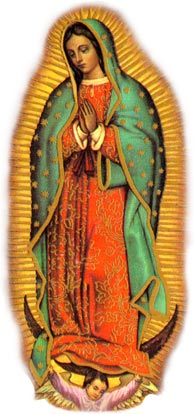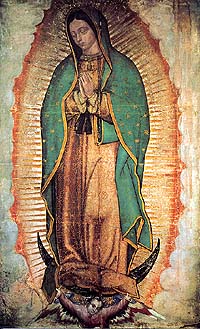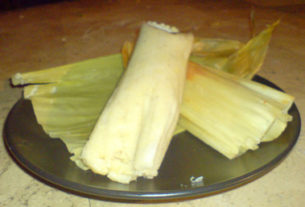Strolling through street markets, browsing the tourist stalls, visitors to all parts of Mexico see mountains of goods featuring the image of the Virgin of Guadalupe. As tourists observe the impossibly colorful image repeated endlessly on caps, T-shirts, key chains, sequined appliqués, mud flaps, decals, bibs, murals, bumper stickers, tiles, candles, religious art, mirrors and tattoos they judge the situation to be clever marketing providing a popular talisman for the poor and uneducated.
While most understand the vulgarizing of a popular local icon to promote sales, they quickly dismiss La Virgen as an amusing bit of folklore. They view the image of the Virgin decorated with bunting and artificial flowers, hanging in homes, stores, churches and even modern factories at the end of each production line as a quaint bit of foreign custom or superstition.
By brushing aside the Virgin and all she represents as tacky commercialism, guests to Mexico are ignoring an important opportunity to begin to understand what is in the hearts, minds and souls of the Mexican people.
THE VIRGIN IS A COMMON DENOMINATOR
 When anthropologists search for a common bond, for the thing that gives Mexicans their national identity, they have to reject the usual concepts. Language did not unite Mexico, as 117 dialects were deciphered by 1575. Ethnic background didn’t provide a bond, not in a country of people who have evolved from raping Spanish fathers, enslaved Indian mothers, with a goodly number of Austrians, French, Germans, Irish, Black, and Chinese added during the ensuing centuries. The geography of this land ranges from tropical seacoasts to grand mountains, huge deserts and mountain mesas. Certainly neither class structure and education, nor occupations nor politics serve to bring the people together as a whole. Even the vast majority of the country served by the Catholic Church find that alone does not make them brothers.
When anthropologists search for a common bond, for the thing that gives Mexicans their national identity, they have to reject the usual concepts. Language did not unite Mexico, as 117 dialects were deciphered by 1575. Ethnic background didn’t provide a bond, not in a country of people who have evolved from raping Spanish fathers, enslaved Indian mothers, with a goodly number of Austrians, French, Germans, Irish, Black, and Chinese added during the ensuing centuries. The geography of this land ranges from tropical seacoasts to grand mountains, huge deserts and mountain mesas. Certainly neither class structure and education, nor occupations nor politics serve to bring the people together as a whole. Even the vast majority of the country served by the Catholic Church find that alone does not make them brothers.
Truly, the Virgin of Guadalupe is the rubber band that binds this disparate nation into a whole. She is the common denominator of this land, it is she giving Mexicans a sense of Nationalism, and Patriotism. Their brotherhood comes from the strength of intense faith rooted in indigenous attributes, images, symbols, magic and myth. The focus of this intense faith revolves around Our Lady, La Virgen Maria de Guadalupe, the mother of God who appeared in Mexico in 1531.
SHE IS THE CRADLE OF MEXICANISM
Beginning to understand the intense relationship between Mexicans and La Virgen is to begin to understand the people of this great and confusing nation of contrasts
In ten years of oppression by the Spaniards, the Indians had been worn down, their spirit was broken, but relatively few had been baptized as Christians. Even those who had been converted to Catholicism missed the closeness of worshipping their own gods. They were separated from the Gods that belonged to them, that looked like them. They felt orphaned by their gods, and then adopted into a religion where they didn’t feel they belonged. When the Virgin Mary of Guadalupe appeared, brown skinned, and speaking a local language, they again had an object of worship that was their very own. She was a shield of the weak, help of the oppressed, the mother of orphans.
The appearance of Guadalupe on Tepeyac, the site of the destroyed Aztec temple of Tonantzin, the Mother Earth Goddess restored the dignity and the spirit of the people. Her arrival is said to mark the birth of a new land and a new people, neither European nor prehispanic, but both, the first product of the New World. Even her physical appearance announced the newness of this world, for her face looked neither like the Spanish nor the Indian. Her lovely features are the pleasant mixture of both – she is a Mestizo, the first Mexican.
Chicana writer Gloria Anzaldua writes, “She is like my race – a synthesis of the old world and the new, of the religion and culture of the two races in our psyche, the conquerors and the conquered.”
THE VIRGIN IS NOT JUST ABOUT THE CHURCH – SHE IS MEXICO
Curiously, the power of belief in the Virgin of Guadalupe has little to do with membership or attendance in the church. In fact, it is said that while 89 of 100 Mexicans are Catholic, it is certain that 100 of 100 Mexicans are Guadalupanas, devotees to the Virgin.
Octavio Paz, Mexican thinker, writer and Nobel prize recipient said, “When Mexicans no longer believe in anything, they will still hold fast to their belief in two things: the National Lottery and the Virgin of Guadalupe. In this I think they will do well. For both have been known to work, even for those of us who believe in nothing.”
The Virgin IS Mexico – fiesta and fervor, food and devoted song, dance and penance. She is the image, the icon that gave birth to a nation and that is the cornerstone of national pride and strength, a symbol of the homeland.
THE VIRGIN IS A SYMBOL OF THE HOMELAND, PATRIOTISM, NATIONALISM
 It has been said that from the moment of her appearance, Guadalupe was a time bomb moving steadily through three centuries to explode into a call for freedom from the oppression of Spain. It was the image of Guadalupe in 1810 that graced the banners of Padre Miguel Hidalgo y Costilla, father of Mexican Independence, as he led the country through 10 years of war for liberty.
It has been said that from the moment of her appearance, Guadalupe was a time bomb moving steadily through three centuries to explode into a call for freedom from the oppression of Spain. It was the image of Guadalupe in 1810 that graced the banners of Padre Miguel Hidalgo y Costilla, father of Mexican Independence, as he led the country through 10 years of war for liberty.
The first president of the Republic, Felix Fernandez changed his name to the very symbolic Guadalupe Victoria.
In 1859 when the government of the first Indian president, Benito Juarez divided church and state, the only remaining religious holiday in the country was December 12, the Day of the Virgin of Guadalupe. The fierce Battle of 5th of May against the French was waged and won at the Hill of Guadalupe, site of the Virgin’s Sanctuary.
Is it any wonder, then, that while in other countries, the First Lady of the land is the wife of the President or Ruler, the Virgin of Guadalupe is the First Lady of Mexico, Mother of all Mexicans and Queen of the Americas.
GUADALUPE, QUEEN OF THE AMERICAS
Guadalupe followed the Mexicans north as they settled the northern reaches of their country, areas that later became the United States. She remained at their side after the Mexican American War, when they were strangers in a strange land..
Today, 150 years later, she continues to accompany Mexicans as they cross the border. She remains the most powerful Chicana icon for Mexicans on the other side. Generations after the immigration of a family to the U.S., grandchildren, great-grandchildren treasure the presence of the Virgin, and recognize her as Mother of all Mexicans.
Even on the U.S. side, Guadalupe’s values and strengths continue to inspire her children toward change, fulfillment and honor. In the 1970’s United Farm Workers’ head Cesar Chavez carried the banner of Guadalupe in his relentless struggle for economic justice for migratory workers.
Chavez and the UFW co-founder Dolores Huerta worked under the slogan ” Si se puede” and the patronage of the Virgin, “She is a symbol of faith, hope and leadership,” says Huerta.
“She has been incorporated into everything we do,” Huerta added. “If she’s not there, you notice her absence right away.” Today Mexican American women in Mexico and the United states are seeing Our Lady of Guadalupe in a new light, using her to demand and expect more from themselves, their jobs, their homes and their communities. Guadalupe is certainly up for this new role, as one woman said, “The virgin transcends all things. She is strength, and she is beauty, and she is wisdom and compassion.”
She is the symbol of ethnic identity, uniting people of different races, religions and languages. She manifests, symbolizes and activates the power of the people. She is a cultural symbol of justice, unconditional love, union, belonging, family, home.
GUADALUPE, MOTHER OF MEXICANS
Guadalupe is Mother to ALL Mexicans, not just the struggling, or the poor or the immigrant. She is there for the wealthy as well as the desperate. She is equally important to the new President of the land as the campesino picking chiles. The junior league and the aged widows in striped rebozos come together on their knees. The gang members and the attorneys find the Virgin their common ground.
Her devotees cross all lines of economics, social standing, and education. Her image hangs around necks on fine gold chains and on rawhide with the same tenderness and depth of emotion and devotion. Her face adorns the silver key chains of high performance vehicles and upscale businesses and homes. With the same pride it is tied on a piece of string to the lead rope of a burro.
Victor Villasenor, grandson of Mexican immigrants to the United States, wrote the story of his family, their life in Mexico, their struggle leaving the country during the revolution and their triumphs in California. In ” Rain of Gold ” he helps outsiders start to understand the one-on-one, member-of-the-family relationship Mexicans have with the Virgin when he tells of his grandmother taking a small glass of whiskey, and her cigarettes to the outhouse each morning, “To have a little talk with the Virgin.”
Huerta, who raised 11 children alone during the very difficult UFW years speaks for millions of Mexicans in many conditions when she says, “I don’t think I could have survived without her.”
Another Mexican said, “Everywhere I go, she is my guide, infusing me with a power that says, ” Si se Puede” (Yes it can be done)”
The always alert and in-charge face of a fiery Mexican woman who spent most of her working years in Hollywood softens, tears fill her eyes, when she speaks of the miracles that have occurred in her family thanks to the Virgin.
Asking most Mexicans what Guadalupe means to them draws incredulous stares and blank looks. They cannot fathom anyone NOT knowing the joy, help and love the Virgin brings to them.
It has never occurred to Guadalupanas that others could see the image as flat, and tacky, a two dimensional piece of religious art. They cannot believe that others are missing out on the unconditional love that makes the Virgin multi-dimensional, alive, and a very real part of the family. She IS, after all, their MOTHER, she is always there, waiting to be consulted, waiting to be consoling, waiting to listen, waiting to speak, to enfold them in her arms, to pull them on to her lap.
In times of joy, Mexicans turn first to light a candle of thanksgiving in front of her image, in the church or in their home. In the darkest despair, her candles light their way. Whether hoping to win a soccer game, a huge contract or the hand of their intended, their petitions and thoughts are always to the Virgin, who has helped so many times before.
World famous singer/song writer Juan Gabriel said, “I saw the Virgin of Guadalupe in Extramadura, Spain, and our Mexican one is better looking. I think I am in love with the image of the Virgin of Guadalupe.”
Recently when a Mexican businessman was asked about his feelings for Our Lady, he paused, took a deep breath, and with a voice deep with emotion, stated, “I love her.” No actor in any love scene ever stated those three words with more meaning.
On her special day, December 12, all of Mexico, and all Mexican sons and daughters on the other side gather for the celebration of the Virgin. An endless parade of pilgrims from the country’s four points appear at her Basilica with their flowers, songs, chants and prayers. They stream in processions led by indigenous dancers, to every church named for her. Wreaths of flowers adorn the signs of streets, neighborhoods, and towns bearing her name. Religious orders, churches and the millions of men, women, boys and girls named for her are especially joyous, as they share her special day.
The nation releases an immense sign of tenderness and experiences a profound expression of Mexican roots and essence and love for Our Lady, Virgen Maria de Guadalupe.
(Typical of the contrasts found in Mexico, devotees can now email petitions to Our Lady of Guadalupe at: [email protected]. The prayers of thanksgiving and petitions for assistance are printed out by a devoted researcher of the history of the Virgin and the miracles of her image. He then takes the emails to lay at her feet, free and confidentially. Once a month, also freely, a mass will be celebrated asking for all who have sent her their prayers, on the very spot when she appeared 530 years ago.)

